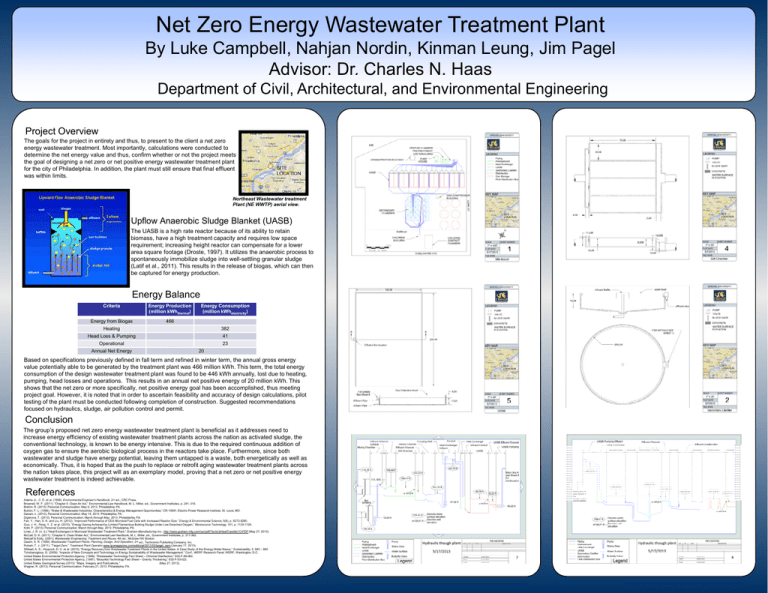Net Zero Energy Wastewater Treatment Plant
advertisement

Net Zero Energy Wastewater Treatment Plant By Luke Campbell, Nahjan Nordin, Kinman Leung, Jim Pagel Advisor: Dr. Charles N. Haas Department of Civil, Architectural, and Environmental Engineering Project Overview The goals for the project in entirety and thus, to present to the client a net zero energy wastewater treatment. treatment Most importantly, importantly calculations were conducted to determine the net energy value and thus, confirm whether or not the project meets the goal of designing a net zero or net positive energy wastewater treatment plant for the city of Philadelphia. In addition, the plant must still ensure that final effluent was within limits. Northeast Wastewater treatment Plant (NE WWTP) aerial view. Upflow Anaerobic Sludge Blanket (UASB) The UASB is a high rate reactor because of its ability to retain biomass, have a high treatment capacity and requires low space requirement; increasing height reactor can compensate for a lower area square footage (Droste, 1997). It utilizes the anaerobic process to spontaneously immobilize sludge into well-settling granular sludge (Latif et al., 2011). This results in the release of biogas, which can then be captured for energy production. Energy Balance Criteria Energy Production (million kWhthermal) Energy from Biogas 466 Energy Consumption (million kWhelectricity) Heating 382 Head Loss & Pumping 41 Operational Annual Net Energy 23 20 Based on specifications previously defined in fall term and refined in winter term, the annual gross energy value potentially able to be generated by the treatment plant was 466 million kWh. This term, the total energy consumption of the design wastewater treatment plant was found to be 446 kWh annually, lost due to heating, pumping, head losses and operations. This results in an annual net positive energy of 20 million kWh. This shows that the net zero or more specifically, net positive energy goal has been accomplished, thus meeting project goal. However, it is noted that in order to ascertain feasibility and accuracy of design calculations, pilot testing of the plant must be conducted following completion of construction. Suggested recommendations focused on hydraulics, sludge, air pollution control and permit. Conclusion The group’s proposed net zero energy wastewater treatment plant is beneficial as it addresses need to increase energy efficiency of existing wastewater treatment plants across the nation as activated sludge, the conventional technology, technology is known to be energy intensive intensive. This is due to the required continuous addition of oxygen gas to ensure the aerobic biological process in the reactors take place. Furthermore, since both wastewater and sludge have energy potential, leaving them untapped is a waste, both energetically as well as economically. Thus, it is hoped that as the push to replace or retrofit aging wastewater treatment plants across the nation takes place, this project will as an exemplary model, proving that a net zero or net positive energy wastewater treatment is indeed achievable. References Adams Jr., C. E. et al. (1999). Environmental Engineer’s Handbook, 2nd ed., CRC Press. Brownell, W. F. (2011). “Chapter 5: Clean Air Act,” Environmental Law Handbook, M. L. Miller, ed., Government Institutes, p. 241- 316. Brehm, R. (2013). Personal Communication. May 9, 2013. Philadelphia, PA. Burton, F. L. (1996). “Water & Wastewater Industries: Characteristics & Energy Management Opportunities,” CR-10691, Electric Power Research Institute, St. Louis, MO. Dasaro, L. (2013). Personal Communication. May 14, 2013. Philadelphia, PA. Digenova, g , T. (2013). ( ) Personal Communication. March through g May, y, 2013. Philadelphia, p , PA. Fan, Y., Han, S. K. and Liu, H. (2012). “Improved Performance of CEA Microbial Fuel Cells with Increased Reactor Size.” Energy & Environmental Science, 5(8), p. 8273-8280. Guo, J. H., Peng, Y. Z. et al. (2010). “Energy Saving Achieved by Limited Filamentous Bulking Sludge Under Low Dissolved Oxygen,” Bioresource Technology, 101, p. 1120-1126. Kohl, P. (2013). Personal Communication. March through May, 2013. Philadelphia, PA. Lines, J. R. (n. d.) “Heat Exchangers in Municipal Wastewater Treatment Plant,” Graham-Manufacturing Inc., http://www.graham-mfg.com/usr/pdf/TechLibHeatTransfer/13.PDF (May 27, 2013). McCall, D. K. (2011). “Chapter 6: Clean Water Act,” Environmental Law Handbook, M. L. Miller, ed., Government Institutes, p. 317-382. Metcalf & Eddy, (2001). Wastewater Engineering: Treatment and Reuse, 4th ed.; McGraw Hill: Boston. Qasim, S. R. (1999). Wastewater Treatment Plants: Planning, Design, And Operation, 2nd ed., Technomic Publishing Company, Inc. Rulseh, T. J. (2011). “Target Zero,” Treatment Plant Operator www.tpomagazine.com/editorial/2011/03/target_zero (January 17, 2013). Stillwell, A. S., Hoppock, D. C. et al. (2010). “Energy Recovery from Wastewater Treatment Plants in the United States: A Case Study of the Energy-Water Nexus,” Sustainability, 2, 945 – 962. Tchobanoglous, G. (2009). “Impacts of New Concepts and Technology on Energy Sustainability of Wastewater Management.” Conf., WERF Research Panel, WERF, Washington, D.C. United States Environmental Protection Agency, (1999). “Wastewater Technology Fact Sheet – Chlorine Disinfection,” 832-F-99-062. United States Environmental Protection Agency, (1987). “Biosolids Technology Fact Sheet – Gravity Thickening,” 832-F-03-022. United States Geological Survey (2013). “Maps, Imagery and Publications,” http://www.usgs.gov/pubprod/ (May 27, 2013). Wagner, R. (2013). Personal Communication. February 21, 2013. Philadelphia, PA. www.postersession.com






